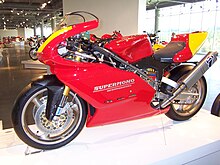Ducati supermono
The Supermono is a motorcycle model from the Italian motorcycle manufacturer Ducati .
The Supermono debuted in 1993 and was designed exclusively for Supermono racing use. A street-legal version was never built. Claudio Domenicali and Massimo Bordi designed the frame, engine and chassis. The shape was designed by Pierre Terblanche , who later became head of design at Ducati . Bonds of the Supermono were later to be found in the new edition of the SuperSport presented in 1998 .
The unusual thing about the Supermono is its engine: Since a new design for a not very prestigious racing class, especially in times of financial difficulties, was not worth it, the tried and tested 90 ° V-2 with desmodromic valve control , intake manifold injection and 4 valves per cylinder was used back, in which the standing cylinder was replaced by a lever with counterweight hinged by the second connecting rod. This construction almost completely eliminated the vibrations typical of one cylinder, so that an extraordinary engine concept emerged out of necessity. Due to the lack of a standing cylinder and the light, self-supporting rear made of carbon fiber reinforced plastic , the center of gravity has sunk compared to other motorcycle concepts, which is beneficial to the driving dynamics .
By the way, a similar principle for mass balancing can now also be found in the two-cylinder in -line engines in BMW motorcycles .
Technical specifications
- Year of construction: 1993–1997
- Displacement: 549/572 cm³
- Engine: 1-cylinder engine, two overhead camshafts, four positive-action valves, liquid-cooled
- Power: 55/59 kW 75/80 PS
- Empty weight: approx. 137 kg
- Transmission: 6-speed
- Top speed: 230–235 km / h
Web links
- Ducati (english)
- Ducati Germany


